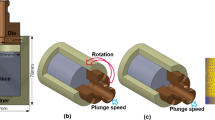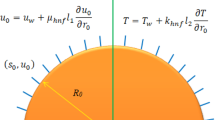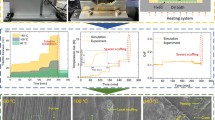Abstract
The friction stir weld (FSW) method was developed in 1991 by The Welding Institute (TWI) and is very useful for manufacturing components with low fusion weldability. The success of this relatively new technique is due, in part, to an appropriate combination of some parameters. In order to understand the influence of the parameters such as rotation speed, axial force, and welding velocity, simulations were carried out using the AISI 304L stainless steel. In this work, the process was considered to be a 3D non-Newtonian fluid and the heat input was calculated from the friction between the tool and the plate and from the plastic deformation. The thermal results were compared with the experimental results from the thermocouple measurements. Furthermore, the material flow was related to the formation of defects observed in the experimental welds. The results of the simulation were able to determine the temperature distribution and heat flow, as well as to predict defects in the welding. The simulated viscosity values enabled the prediction of the parameters most likely to cause the formation of flashes. In addition, the injection of inert particles into the model made it possible to predict the formation of wormholes.












Similar content being viewed by others
References
Wayne M, Thomas WM, Norris IM, Nicholas ED, Needham JC, Murch MG, Temple-Smith P, Dawes CJ (1991) Friction stir welding process developments and variant techniques, 1991. Patent Application no 397 PCT/GB92/02203 and GB Patent Application no. 9125978.9
Thomas WM, Nicholas ED (1997) Friction stir welding for the transportation industries. Materials & Design 18(4):269–273. ISSN 0261-3069. https://doi.org/10.1016/S0261-3069(97)00062-9
Nandan R, Roy GG, Debroy T (2006) Numerical simulation of three-dimensional heat transfer and plastic flow during friction stir welding. Metallurgical and Materials Transactions 37A(4):1247–1259. ISSN 1073-5623. https://doi.org/10.1007/s11661-006-1076-9
Cho HH, Hong ST, Roh JH, Choi HS, Kang SH, Steel RJ, Han HN (2013) Three-dimensional numerical and experimental investigation on friction stir welding processes of ferritic stainless steel. Acta Materialia 61(7):2649–2661. ISSN 13596454. https://doi.org/10.1016/j.actamat.2013.01.045
Kim SD, Yoon JY, Na SJ (2017) A study on the characteristics of FSW tool shapes based on CFD analysis. Welding in the World 61(5):915–926. ISSN 00432288. https://doi.org/10.1007/s40194-017-0478-1
Patel V, Li W, Vairis A, Badheka V (2019) Recent development in friction stir processing as a solid-state grain refinement technique: microstructural evolution and property enhancement. Critical Reviews in Solid State and Materials Sciences 44(5):378–426. ISSN 15476561. https://doi.org/10.1080/10408436.2018.1490251
Wen Q, Li WY, Wang WB, Wang FF, Gao YJ, Patel V (2019) Experimental and numerical investigations of bonding interface behavior in stationary shoulder friction stir lap welding. Journal of Materials Science and Technology 35(1):192–200. ISSN 10050302. https://doi.org/10.1016/j.jmst.2018.09.028
Su Y, Li W, Patel V, Vairis A, Wang F (2019) Formability of an AA5083 aluminum alloy T-joint using SSFSW on both corners. Materials and Manufacturing Processes 34(15):1737–1744. ISSN 15322475. https://doi.org/10.1080/10426914.2019.1669799
Sato YS, Nelson TW, Sterling CJ, Steel RJ, Pettersson C-O (2005) Microstructure and mechanical properties of friction stir welded saf 2507 super duplex stainless steel. Materials Sci Eng A 397(1):376–384. ISSN 0921-5093. https://doi.org/10.1016/j.msea.2005.02.054
Meng X, Huang Y, Cao J, Shen J, dos Santos JF (2021) Recent progress on control strategies for inherent issues in friction stir welding. Progress in Materials Science 115(June 2020). ISSN 00796425. https://doi.org/10.1016/j.pmatsci.2020.100706
Arbegast WJ (2008) A flow-partitioned deformation zone model for defect formation during friction stir welding. Scripta Materialia 58(5):372–376. ISSN 13596462. https://doi.org/10.1016/j.scriptamat.2007.10.031
Khan NZ, Siddiquee AN, Khan ZA, Shihab SK (2015) Investigations on tunneling and kissing bond defects in FSW joints for dissimilar aluminum alloys. Journal of Alloys and Compounds 648:360–367. ISSN 09258388. https://doi.org/10.1016/j.jallcom.2015.06.246
Kainuma S, Katsuki H, Iwai I, Kumagai M (2008) Evaluation of fatigue strength of friction stir butt-welded aluminum alloy joints inclined to applied cyclic stress. Int J Fatigue 30(5):870–876. ISSN 01421123. https://doi.org/10.1016/j.ijfatigue.2007.06.007
Zhou C, Yang X, Luan G (2006) Effect of kissing bond on fatigue behavior of friction stir welds on Al 5083 alloy. Journal of Materials Science 41(10):2771–2777. ISSN 00222461. https://doi.org/10.1007/s10853-006-6337-x
Zheng Q, Feng X, Shen Y, Huang G, Zhao P (2017) Effect of plunge depth on microstructure and mechanical properties of FSW lap joint between aluminum alloy and nickel-base alloy. Journal of Alloys and Compounds 695:952–961. ISSN 09258388. https://doi.org/10.1016/j.jallcom.2016.10.213
Frigaard Ø, Grong Ø, Midling OT (2001) A process model for friction stir welding of age hardening aluminum alloys. Metallurgical and Materials Transactions A 32(5):1189–1200. ISSN 1073-5623. https://doi.org/10.1007/s11661-001-0128-4
Seidel TU , Reynolds AP (2003) Two-dimensional friction stir welding process model based on fluid mechanics. Science and Technology of Welding and Joining 8(3):175–183. ISSN 1362-1718. https://doi.org/10.1179/136217103225010952
Sellars CM, McG WJ, Tegart (1972) Hot workability. Int Metallurgical Rev 17(1):1–24. ISSN 0367-9020. https://doi.org/10.1179/imtlr.1972.17.1.1
Sheppard T, Wright DS (1979) Determination of flow stress: part1 constitutive equation for aluminum alloys at elevated temperatures. Metal Technology June(June):215–223. ISSN 0307-1693. https://doi.org/10.1179/030716979803276264
Ulysse P (2002) Three-dimensional modeling of the friction stir-welding process. Int J Machine Tools & Manufacture 42(July):1549–1557. ISSN 0890-6955. https://doi.org/10.1016/S0890-6955(02)00114-1
Nandan R, Lienert TJ, DebRoy T (2008) Toward reliable calculations of heat and plastic flow during friction stir welding of Ti-6Al-4V alloy. Int J Materials Res 99(4):434–444. ISSN 1862-5282. https://doi.org/10.3139/146.101655
Zhu Y, Chen G, Chen Q, Zhang G, Shi Q (2016) Simulation of material plastic flow driven by non-uniform friction force during friction stir welding and related defect prediction. Materials & Design 108:400–410. ISSN 0264-1275. https://doi.org/10.1016/j.matdes.2016.06.119
Caetano GQ (2016) Soldagem similar de aços inoxidáveis ferríticos e austeniticos pelo processo “friction stir welding” (joining of similar ferritic and austenitic stainless steels by the “friction stir welding” process). Master’s thesis, Universidade Federal do ceará, Campus do Pici - Bloco 729 CEP 60.440-554 - Fortaleza - CE, 2
Almoussawi M, Smith AJ (2018) Thermo-mechanical effect on poly crystalline boron nitride tool life during friction stir welding (dwell period). Metals and Materials International 24(3):560–575. ISSN 2005-4149. https://doi.org/10.1007/s12540-018-0074-y
Song KJ, Dong ZB, Fang K, Zhan XH, Wei YH (2014) Cellular automaton modelling of dynamic recrystallisation microstructure evolution during friction stir welding of titanium alloy. Materials Sci Technol 30(6):700–711. ISSN 0267-0836. https://doi.org/10.1179/1743284713Y.0000000389
Hart EW (1976) Constitutive relations for the nonelastic deformation of metals. J Eng Materials Technol 98(3):193. ISSN 00944289. https://doi.org/10.1115/1.3443368
Cho JH, Boyce DE, Dawson PR (2005) Modeling strain hardening and texture evolution in friction stir welding of stainless steel. Materials Science and Engineering A 398(1-2):146–163. ISSN 09215093. https://doi.org/10.1016/j.msea.2005.03.002
Fisher ES (1966) Temperature dependence of the elastic moduli in alpha uranium single crystals, part iv (298 to 923 K). Journal of Nuclear Materials 18(1):39–54. ISSN 00223115. https://doi.org/10.1016/0022-3115(66)90094-8
Silva YC, Oliveira FJV JR, Marcondes F, Silva CC (2020) Analysis of viscosity function models used in friction stir welding. Journal of the Brazilian Society of Mechanical Sciences and Engineering. https://doi.org/10.1007/s40430-020-02504-1
Ma ZY, Feng AH, Chen DL, Shen J (2018) Recent advances in friction stir welding/processing of aluminum alloys: microstructural evolution and mechanical properties. Critical Reviews in Solid State and Materials Sciences 43(4):269–333. ISSN 15476561. https://doi.org/10.1080/10408436.2017.1358145
Su H, Wu CS, Pittner A, Rethmeier M (2014) Thermal energy generation and distribution in friction stir welding of aluminum alloys. Energy 77:720–731. ISSN 03605442. https://doi.org/10.1016/j.energy.2014.09.045
Author information
Authors and Affiliations
Corresponding author
Additional information
Publisher’s note
Springer Nature remains neutral with regard to jurisdictional claims in published maps and institutional affiliations.
Recommended for publication by Commission III - Resistance Welding, Solid State Welding, and Allied Joining Process.
Appendix. Constants
Appendix. Constants
Rights and permissions
About this article
Cite this article
da Silva, Y.C., Oliveira Júnior, F.J.V., dos Santos, J.F. et al. Numerical investigation of the influence of FSW parameters on the heat and mass transfer of austenitic stainless steels. Weld World 64, 2019–2032 (2020). https://doi.org/10.1007/s40194-020-00980-6
Received:
Accepted:
Published:
Issue Date:
DOI: https://doi.org/10.1007/s40194-020-00980-6




